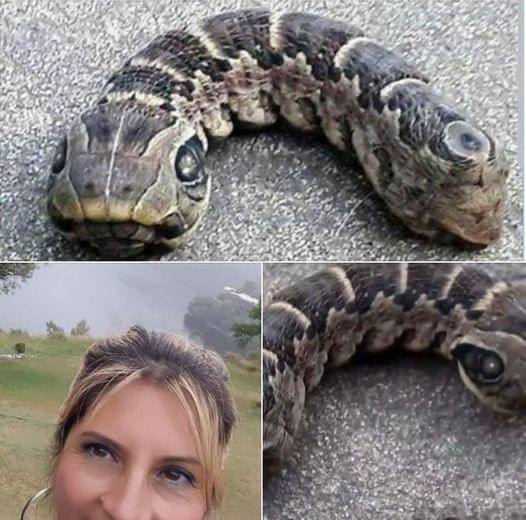A woman came across this MONSTER in the back garden and thought it was a two-headed snake. When she realized what it was, she ran into the house, screaming in fear: – Check the comments 👇👇👇
Woman Discovers a Bizarre Snake-like Creature in Her Garden—But What It Really Is Will Leave You Stunned Imagine strolling through your…
Imagine strolling through your peaceful garden, the soft hum of insects in the air, when suddenly, you stumble upon something entirely out of place—a creature so strange, so alien-looking, that you’re not sure if it belongs in the pages of a wildlife magazine or a sci-fi movie. That’s exactly what happened to Lujan Eroles, a 46-year-old woman from Santa Fe, Argentina, whose routine day took an extraordinary turn when she came face-to-face with a mysterious being she could only describe as snake-like.
At first glance, the small creature appeared to be a snake, slithering subtly through her garden. But something about it was off. It was only about 10 centimeters long, far too short for a typical snake, and its eyes—if you could even call them that—were unusually large and hypnotic. Confused, and admittedly a little scared, Lujan hesitated. Was it venomous? Could this small, unassuming creature pose a danger to her?
Curiosity got the better of her, and she cautiously filmed the creature, hoping to capture this odd moment on camera. What she didn’t realize was that her short video clip would spark an online frenzy, leading to widespread speculation and debate. What exactly had she found?
The Encounter That Shocked an Entire Town
“I have never seen anything like it in my life,” Lujan later shared, her voice still tinged with disbelief. “It looked just like a snake, and its eyes were so strange. I was afraid it might be poisonous, so I didn’t want to get too close.” Her concern wasn’t unfounded—living in a rural area, encounters with dangerous wildlife are always a possibility.
As the video circulated on social media, the mystery deepened. Some viewers insisted it was an exotic, venomous species that had somehow found its way to Argentina. Others suggested it could be an undiscovered species entirely. The creature’s eerie, snake-like appearance—with its large, dark eye spots—lent itself to countless theories.
But it wasn’t long before experts chimed in, revealing the creature’s true identity. And what they had to say was far more fascinating than anyone could have imagined.
Unraveling the Mystery: Nature’s Master of Disguise
As it turns out, the “snake” wasn’t a snake at all. It was, in fact, a caterpillar—yes, a caterpillar! But not just any ordinary garden critter. This was the larva of a rare Central American moth species, quite possibly an Elephant Hawk-Moth caterpillar (Deilephila elpenor), known for its incredible ability to mimic snakes as a form of defense.
The caterpillar, which is completely harmless to humans, has evolved a survival strategy that would make any predator think twice before making it a meal. Its “eyes” were not real eyes at all but false markings designed to scare off potential threats. These eye-like spots, located just behind the head, give the impression that the caterpillar is far more dangerous than it truly is—like a venomous serpent ready to strike.
This clever mimicry works like a charm, deterring birds, rodents, and other predators that might otherwise see the caterpillar as an easy snack. And Lujan wasn’t the first to be fooled by this remarkable disguise. Nature’s design here is nothing short of genius—using fear to outsmart bigger and stronger adversaries without ever needing to lift a finger, or in this case, slither.
The Science of Mimicry: How the Caterpillar Pulls Off Its Snake Illusion
So, how does this tiny caterpillar manage to fool even the most discerning eyes? The answer lies in a combination of its physical appearance and behavior. When threatened, the caterpillar expands its body, accentuating the snake-like eye spots on its back. It will even rear up its head and sway slightly, mimicking the movements of a real snake. To any predator, this display would be enough to suggest they were dealing with something far more formidable than a defenseless insect.
This adaptation, called Batesian mimicry, is one of nature’s most fascinating survival tactics. It allows harmless species to mimic the appearance or behavior of harmful ones, reducing their chances of being eaten. While this caterpillar doesn’t have venom or fangs, its ability to play pretend is an evolutionary masterpiece that has likely saved it countless times throughout the ages.
For Lujan Eroles, this chance encounter with one of nature’s tricksters became a reminder of the rich biodiversity hiding in plain sight, even in our own backyards. It’s easy to forget that such incredible creatures exist, quietly going about their lives, armed with ingenious tactics passed down by nature itself.
A Call to Curiosity and Wonder
The discovery of this caterpillar wasn’t just a curiosity for Lujan; it also sparked a renewed sense of wonder about the natural world for everyone who came across her story. “I was so shocked at first,” she admitted, “but now I’m fascinated. It’s amazing what nature can do.”
And she’s right—nature is amazing. From the tiniest insects to the largest mammals, the world is full of wonders waiting to be discovered, each with its own story to tell. This little caterpillar, with its snake-like facade, is just one of countless examples of how life on Earth has evolved in extraordinary ways to survive and thrive.
So, the next time you find yourself in your garden or wandering through the woods, take a closer look. That strange creature scurrying by might just have a secret identity you’d never expect. Who knows what other hidden marvels are out there, waiting to be found?
A Reminder to Stay Curious
Lujan’s discovery in the garden reminds us of one important thing: nature is full of surprises. And while we may think we’ve seen it all, there’s always something new to learn, something unexpected to encounter. Whether it’s a caterpillar pretending to be a snake or an animal using camouflage to blend into its surroundings, these natural wonders are all around us. We just need to keep our eyes open, stay curious, and let nature astonish us with its endless creativity.
What started as a moment of fear turned into a remarkable discovery—proof that even in the most ordinary places, we can find the extraordinary.






